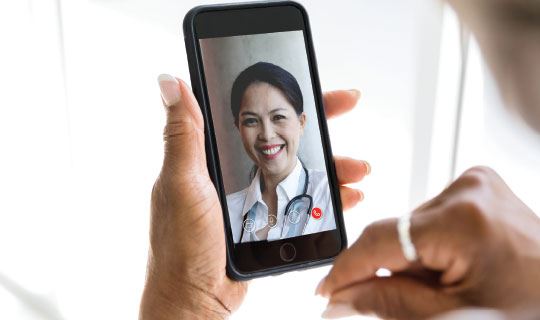You don't have to be a technology whiz to have a visit with your doctor.
Virtual online doctor visits have been available for some time—but since the COVID-19 pandemic, they’ve soared. “During just one week in April, doctors in our medical group conducted more than 10,000 telemedicine visits,” says Andy Anderson, MD, President and Chief Executive Officer of the RWJBarnabas Health medical group.
Stay-home orders during the lockdown have played a huge role in the increase, but other causes are also speeding up telemedicine’s adoption. Dr. Anderson tells how and why:
1. What factors are contributing to telemedicine’s surge?
Historically, demand for telemedicine was driven by urgent issues, rather than by routine or other kinds of care. Habit has played a role, too—the expectation that patients and physicians need to physically be together in order to get the best possible care.
Now, there’s a greater openness to using technology platforms in all realms of our lives. Those platforms are increasingly sophisticated, so that patients and providers can really see each other, see the parts of the body in question and read each other’s expressions.
In the RWJBarnabas Health medical group, we have an easy-to-use platform for telemedicine visits. It’s as simple as a click to get into a virtual room for an appointment. It’s also secure and is fully HIPAA-compliant.
2. What are some examples of conditions that can be treated in a virtual visit?
Let’s say a person falls and cuts himself. A telemedicine visit can help determine whether he needs stitches and/or an antibiotic. Symptoms and treatment for a urinary tract infection can also be discussed virtually. If someone has a sore throat, he or she can show the back of the throat and tonsils to the doctor via video. Chronic conditions, such as COPD [chronic obstructive pulmonary disease], congestive heart failure or asthma could be managed through a video visit, as a physician is able to observe whether a person is short of breath, for example, or whether his legs are swollen.
Diabetes that is not well controlled can also be discussed, as the patient can report his blood sugar levels and medication can be adjusted accordingly. It’s important to note that in any of these cases, a visit can begin as a video visit and then become an in-person visit if the condition warrants it. If you aren’t sure what the best course of action is— video, in-person office visit or Emergency Department visit—don’t feel you have the burden of having to make the decision on your own. Call your physician’s office and have a conversation.
3. What about well visits and checkups?
Clearly, some exams and procedures require an in-person visit. However, many aspects of a wellness visit, specifically a Medicare Annual Wellness Visit, can be conducted virtually. A physician can ask about, for example, colon cancer screenings or mammograms, home safety and more. Patients like that they can save time and don’t have to travel.
In addition, we’re hoping to see increased use of monitoring devices that can transmit information from patient homes to physician offices, including blood pressure monitors, blood glucose monitors, pulse oximeters and even wireless scales.
4. Am I at risk for contagion if I visit a physician’s office?
At RWJBarnabas Health medical group offices, we’ve taken the necessary steps to make it very safe to visit in person. We have social distancing plans, including the use of Plexiglas barriers, a distance line at checkout areas, modified waiting room seating and limitations on the number of patients scheduled during a specified time frame. We also follow rigorous cleaning regimens, offer hand sanitizer stations and more.
5. Are telemedicine visits covered by insurance?
During the early stages of the pandemic, Medicare, Medicaid and many private insurances expanded their coverage for telemedicine. The situation is evolving, so check with your insurer, but our sense is that coverage for telemedicine will continue to expand.
6. How will telemedicine change health care in the future?
While the COVID-19 crisis has pushed us into this world fast, I think health care will be sticking with telemedicine from now on. Telemedicine is not a solution for everything, but it is a solution for a lot more things than we realized. It’s a great tool to have in our toolkit. The most important message we have for patients is to continue to make your health a priority.
Don’t put off care if you aren’t feeling well, or postpone contacting your physician for help managing any chronic health conditions. Whether virtually or in person, your provider is there to help you.
Checklist for the best virtual visit
- Be sure the device you’re using (phone, tablet, computer) is fully charged.
- Make the call from a well-lit and quiet room to enhance the quality of the video and audio feeds.
- If you need an interpreter, let your physician’s office know ahead of time.
- In advance, write down your symptoms, when they began and how frequent they are, and any medications you’re taking.
- Keep a pen and notepad handy during the visit.
To connect with an RWJBarnabas Health medical group provider, call 888.724.7123 or visit www.rwjbh.org/medicalgroup.
